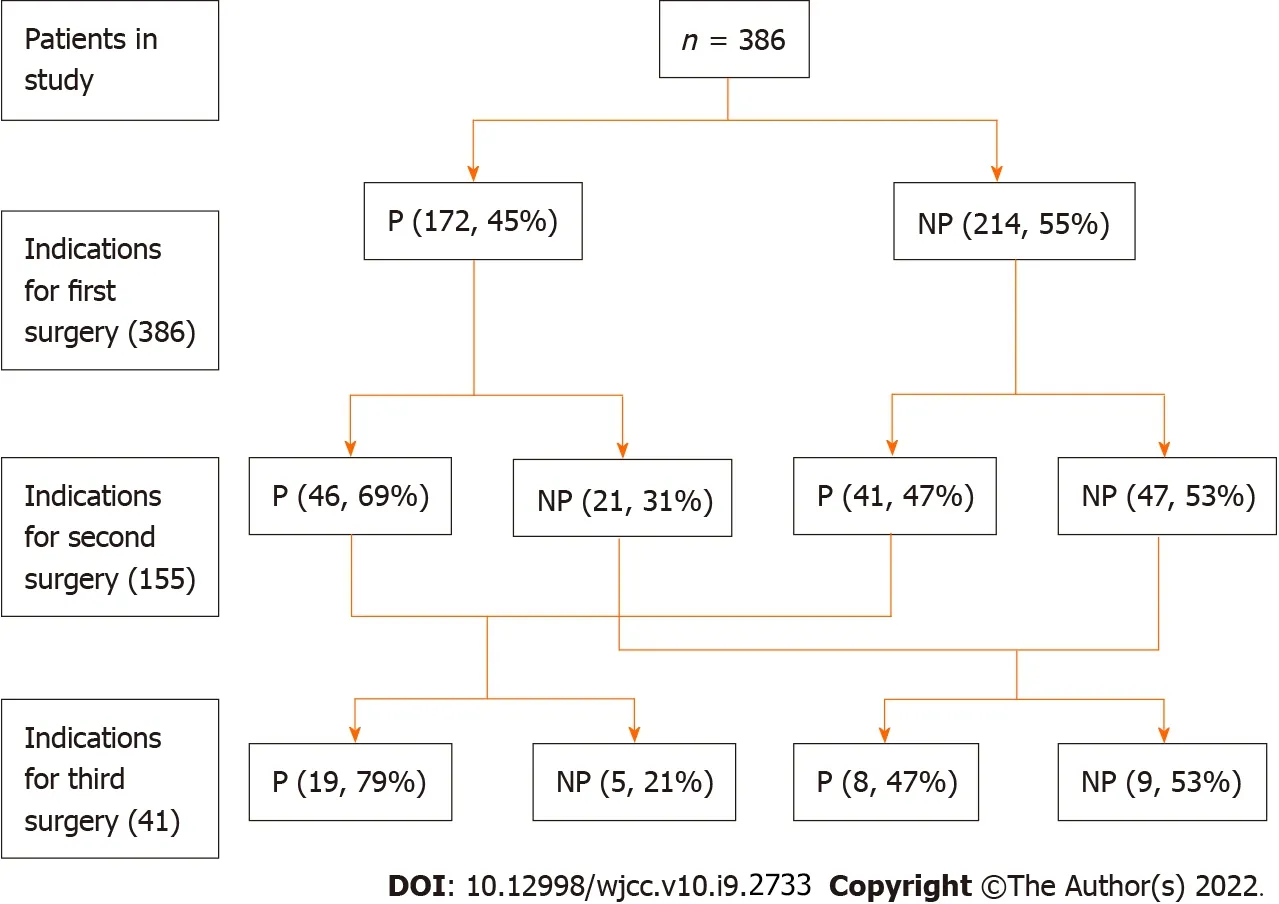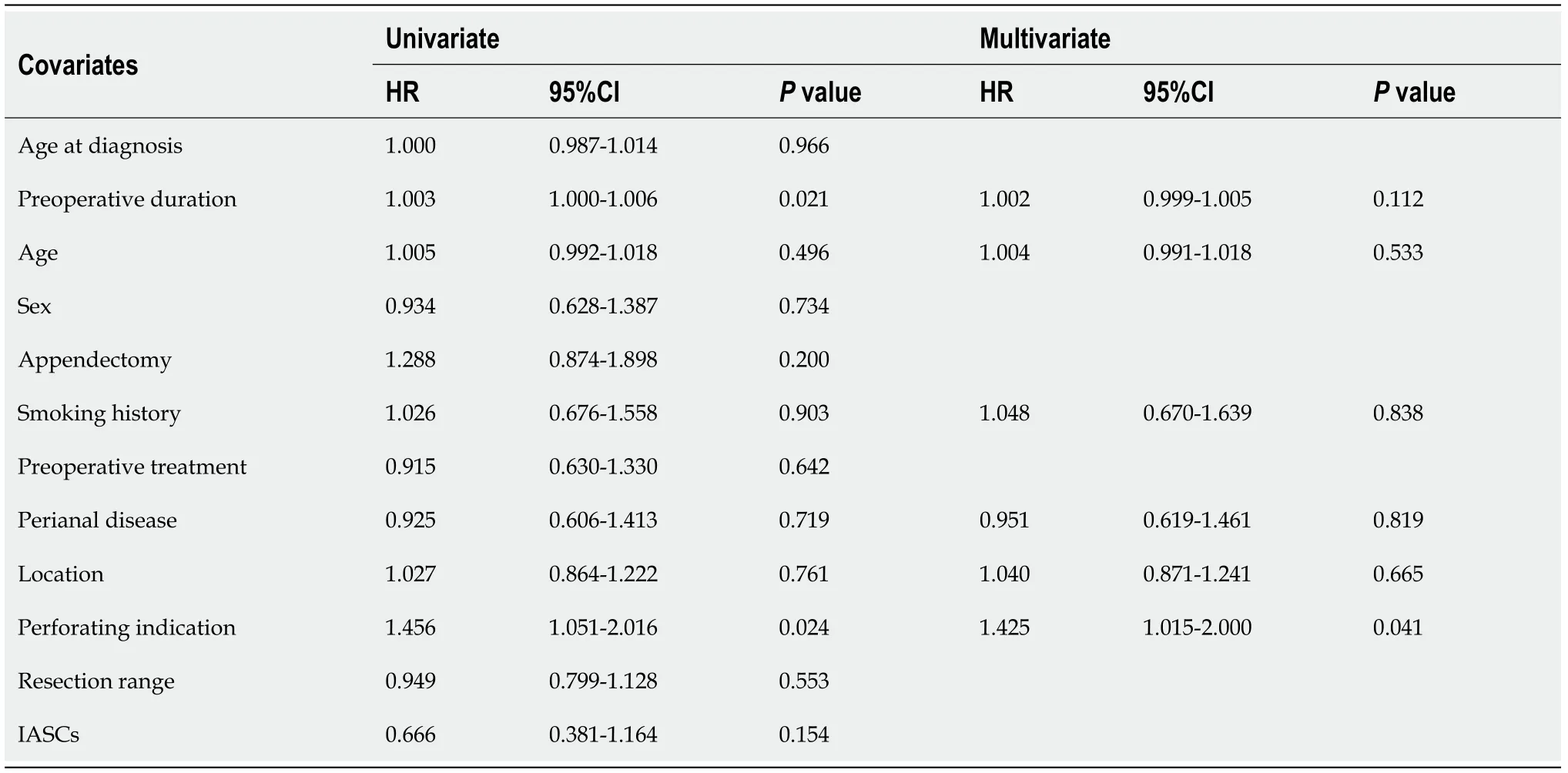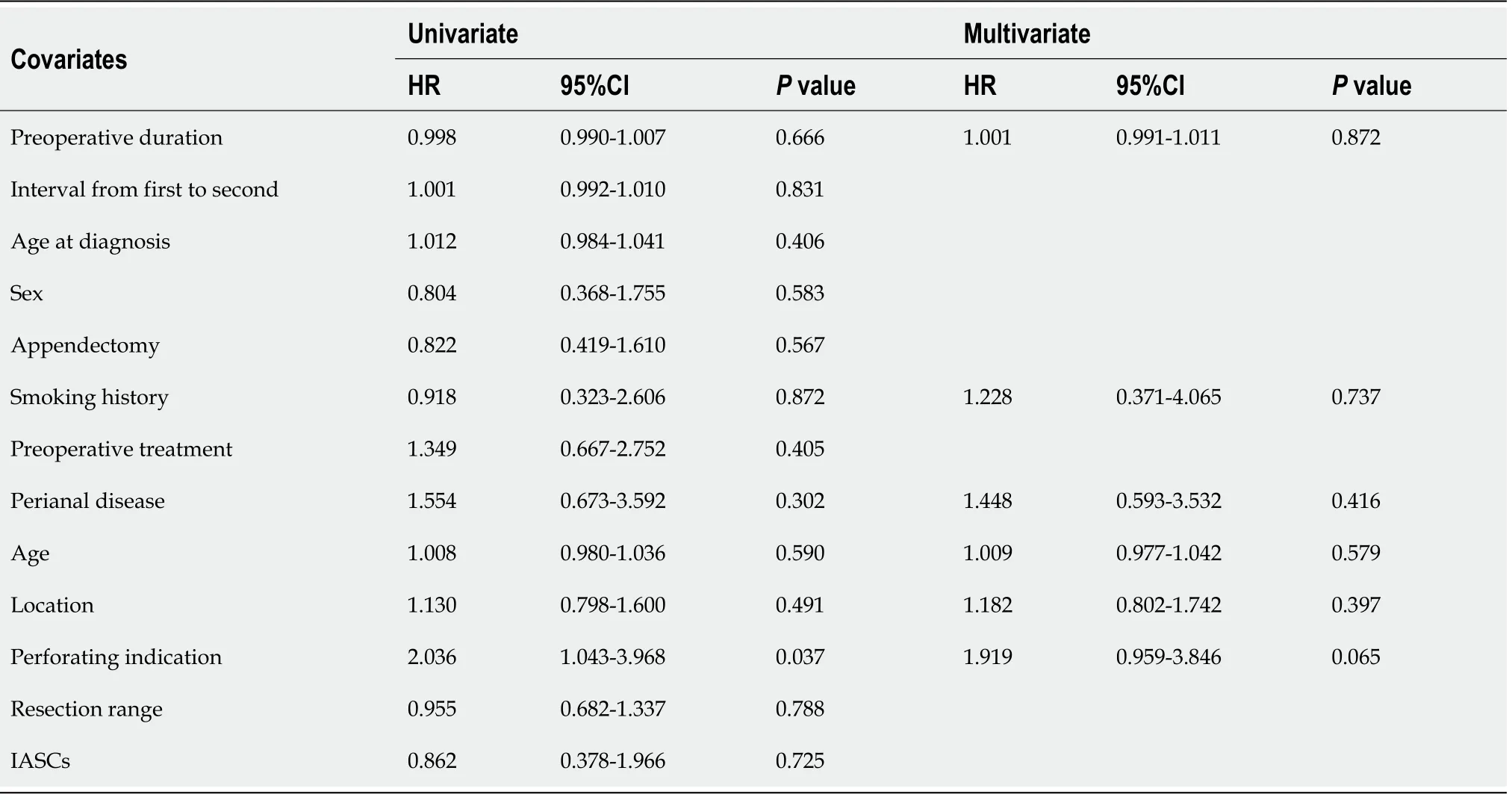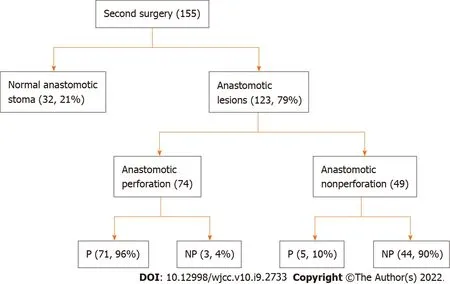Perforating and nonperforating indications in repeated surgeries for Crohn’s disease
2022-06-22WeiSongShenXiaoHuiHuangRuiQingLiuChenYangLiYiLiWeiMingZhu
lNTRODUCTlON
Crohn’s disease(CD)is a chronic inflammatory bowel disease(IBD)of unknown etiology;it is extremely difficult to predict the clinical course of CD patients.In recent years,the incidence of CD has increased dramatically in China[1].Despite advances in medical therapy for CD(such as antitumor necrosis factor antibodies and immunosuppressive drugs),antitumor necrosis factor antibodies can effectively promote the healing of intestinal mucosa and reduce the operation risk and hospitalization rate.However,in clinical practice,up to 30% of patients have a loss of response to biological therapy.Most CD patients still require partial bowel resection at least once during the CD course[2,3].
Surgical intervention is necessary for patients with acute perforation,internal fistulae,peritoneal abscess,intestinal obstruction,toxic dilatation,hemorrhage,and/or failed response to medical therapy[4].Surgery is effective in removing the lesions and relieving symptoms;however,surgical resection is not curative for CD,and postoperative recurrence is common.Recurrence may occur in 25%-38% of CD patients,necessitating a second surgery within 5 years postoperatively.Moreover,a third surgery owing to recurrent CD is required in an estimated 33% of these patients[5].Postoperative prophylaxis can reduce CD recurrence rates[6],but only patients with risk factors for earlier postoperative recurrence should be considered for postoperative prophylaxis due to the risks of immunosuppressive therapy.Therefore,to delay postoperative recurrence,it is important to analyze the clinical characteristics and predict postoperative recurrence for surgical patients.Several studies have assessed the risk factors for postoperative CD recurrence.Reported risk factors for postoperative recurrence include a smoking habit,family history,young age at diagnosis,ileocolonic disease,perianal disease,preoperative duration and perforating lesions[7-10].
The aim of the current study was to compare the clinical characteristics between the first,second and third surgeries,analyze correlations of the perforating and nonperforating indications,and identify the anastomosis characteristics for postoperative CD.
MATERlALS AND METHODS
Patients
Data were retrospectively reviewed from CD patients treated between 2003 and 2013 in Jinling Hospital,Medical School of Nanjing University.All included patients were preoperatively diagnosed with CD based on conventional clinical features,abdominal computed tomography,and endoscopy,and the CD diagnosis was postoperatively confirmed by histological analysis of the surgical specimen.Patients who had undergone at least one surgical resection for CD were considered for study enrollment.Endoscopies were performed at 3 mo,6 mo and every year after surgery.All patients were contacted by telephone and asked to participate in the study.All patients gave informed written consent.This study was approved by the Jinling Hospital Ethics Committee.
Definitions
Patient age and disease location were based on the Montreal classification[11].Indication for surgery was defined as the main reason for surgical resection based on clinical features,preoperative diagnostic examinations,and intraoperative findings.The indications were classified into two categories based on the report by Simillis[12]perforating indications included acute free perforation,internal or external fistula,and abscess;nonperforating indications included intestinal obstruction,medical intractability,and hemorrhage.Recurrence was defined as the need for reoperative surgery.
Data collection
Clinical characteristics,including age at diagnosis,sex,age at the time of surgery,appendectomy history,preoperative duration,smoking history,perianal disease,indication for surgery,and disease location,were retrospectively collected for each patient by two independent individuals(W.S.and X.H.).We also collected operative records,including resection range and occurrence of postoperative intra-abdominal septic complications(IASCs).Serum albumin,C-reactive protein,and BMI were also collected after patient admission.The deadline for follow-up was February 2017.All patients were followed-up at regular intervals.
Statistical analysis
Statistical analysis was performed using SPSS version 19.0(Chicago,IL,United States).Correlations of clinical characteristics between the repeated surgeries were tested for statistical significance using Pearson’stest.The paired-sampleswas used to assess differences in recurrence-free survival after the first and second surgeries.For analysis of recurrence-free survival data related to perforating indication,cumulative survival curves were created using the Kaplan-Meier method;the difference between the curves was analyzed by the log-rank test.Univariate and multivariate survival analyses were carried out using the Cox proportional hazards model.Spearman’s correlation coefficient test was used to assess associations of perforating indications for multiple operations.A value of< 0.05 was considered statistically significant,and allvalues were two-sided.
RESULTS
Clinical characteristics of patients
Please, mister, please, I m sorry. I didn t know what else to do! pleaded the youngster. It s my brother, he said. He rolled off the curb4 and fell out of his wheelchair and I can t lift him up.
What you have got to do now is to go on your knees to the king and crave34 his pardon, and before he consents to a peace you will have to implore35 him to grant you the favour of becoming his wife
Surgical indication between multiple operations
The perforating and nonperforating indications of the initial surgery were correlated with the surgical indication of the second surgery(= 0.006,= 0.220),and the surgical indication of the second surgery was also correlated with that of the third surgery(= 0.033,= 0.334)(Figure 1).Perforating disease tends to represent as perforating disease and nonperforating as nonperforating.Even with the correlation of surgical indications between repeated operations,the rate of CD perforation behavior as an indication for the second and third surgeries was significantly higher than that for the first surgery(Figure 2).Therefore,although CD can retain disease behavior after surgery,CD is a chronic disease characterized by progressive bowel destruction and will eventually develop a perforation.CD not only has stable characteristics but also progresses chronically.

Postoperative recurrence
After the first surgery,perforating indication(HR 1.456,95%CI 1.051-2.016)and preoperative disease duration(HR 1.003,95%CI 1.000-1.006)were significantly associated with recurrence-free survival in theunivariate analysis.In multivariate analysis,only perforating indication significantly affected the outcome of recurrence and appeared to be an independent prognostic factor(HR 1.425,95%CI 1.015-2.000)(Table 2).


Table 3 shows the results of the univariate and multivariate Cox proportional hazard model analyses after the second surgery.In the univariate analysis,only perforating indication(HR 2.036,95%CI 1.043-3.968)was significantly associated with recurrence-free survival.In the multivariate analysis,none of the factors affected the outcome of recurrence.

Postoperative anastomosis characteristics
Anastomotic lesions were the most common sites of recurrence after the operation.In the second surgery,79% of lesions occurred at anastomotic sites.The surgical indication of the second surgery was correlated with the behavior of anastomosis(= 0.000,= 0.917)(Figure 3).In the third surgery,90% of lesions occurred at anastomotic sites.Concordance was found between anastomotic lesion behavior and indication for the third surgery(= 0.000,= 0.940)(Figure 4).



DlSCUSSlON
Due to the relatively low morbidity and clinical experience in CD in China,there is limited research on CD in our country,especially regarding surgical treatment.In the current study,we analyzed the clinical characteristics of repeated operations in CD,assessed the risk factors for surgical recurrence,and identified the clinical characteristics of perforating indications as common risk factors for postoperative recurrence among CD patients treated with different surgical frequencies.Moreover,our study analyzed correlations and anastomosis characteristics in repeated surgeries for Crohn’s disease.
And when, through the window, she saw the sun thus rising, she said, Cannot I, too, order the sun and moon to rise? Husband, she said, poking25 him in the ribs26 with her elbows, wake up! go to the Flounder, for I wish to be even as God is
Shen WS,Huang XH,and Liu RQ contributed equally to this work,studied conception and design,and drafting of manuscript;Li CY contributed to acquisition of data;Li Y analysis and interpretation of data;Zhu WM contributed to critical revision.
Postoperative recurrence is a major problem for CD patients[15,16].Identifying the risk factors associated with postoperative recurrence will markedly benefit patients with CD and will permit doctors to maintain close postoperative surveillance in high-risk cases and optimize CD therapy[17,18].Although there are conflicting results in the reports according to whether the perforating indication for surgery affects postoperative recurrence[19,20],some studies have indicated that perforating CD is a risk factor for earlier recurrence[21].Our results showed that the perforating indication was a predictor of surgical recurrence,which confirmed the concept that the perforating indication for surgery was associated with decreased recurrence-free survival.Moreover,we found that a longer preoperative disease duration was significantly associated with a shorter period of postoperative recurrence after the first surgery.As the duration of CD symptoms before surgery may be uncertain,relatively few studies have shown a significant association between preoperative disease duration and earlier recurrence of postoperative CD.Our results agree with that of Lautenbach[22],who reported an association between higher recurrence rates and a longer preoperative duration.Antitumor necrosis factor antibodies have been proven to prevent postoperative recurrence[23].However,infliximab therapy did not significantly affect the outcome of postoperative recurrence in the univariate and multivariate analyses in our study.Moreover,anastomotic lesions were the most common sites of recurrence after the operation.anastomosis might be a new type of disease location for the classification of CD after surgery.
And when the rain comes from that quarter, which side do you turn to? And the heron replied, And which side do you turn to? Oh, I always turn to this side, said the jackal
Several limitations of our study need to be considered.As most medical records were collected retrospectively,a potential bias may exist.Additionally,patients may not accurately remember their smoking habits,which may affect the significance of smoking as a risk factor.However,as an IBD center that focuses on surgical treatment in China,most data were accurately collected in our academic database or acquired by interviewing CD patients.
There were 386 hospitalized patients who had undergone at least one surgical resection in our department;155 of these patients had undergone two surgical resections,and 41 of these 155 patients had undergone at least three surgical resections.A final total of 386 CD patients were included in this study.The clinical features are shown in Table 1.There were no significant differences between surgeries in sex,appendectomy history,smoking history,perianal disease or IASCs(> 0.05).
CONCLUSlON
In conclusion,patients can retain their disease behavior after surgery,and the rate of perforating CD increases as the surgical frequency increases.CD not only has stable characteristics but also progresses chronically.Perforation is a progressive surgical indication for Crohn’s disease.Anastomosis might be a new classification of disease location for postoperative CD.These factors may help to stratify patients for preventive treatment.
ARTlCLE HlGHLlGHTS
Research background
It was well-known that Crohn’s disease(CD)is a chronic disease characterized by progressive bowel destruction.Despite advances in medical therapy for CD,most patients with CD require repeated resection surgeries.
Research motivation
All patients were contacted by telephone and asked to participate in the study.All patients gave informed written consent.
Research objectives
The aim of the current study was to analyze the perforating and nonperforating indications of repeated CD operations and identify the anastomosis characteristics for postoperative CD.
On her way out to the plane, which was still refueling, Dana saw the employee who had initially5 ignored the old man. The employee said, You re lucky the plane didn t leave without you.
Research methods
Clinical characteristics of each surgery were collected.Univariate and multivariate analyses were performed to determine risk factors for recurrence.
Research results
He looked at us and said, I wish you could have met my Dad. He was a big man, and he was strong from pulling the nets and fighting the seas for his catch. When you got close to him, he smelled like the ocean. He would wear his old canvas(), foul-weather coat and his bibbed overalls1. His rain hat would be pulled down over his brow. No matter how much my Mother washed them, they would still smell of the sea and of fish.
Even if the correlation of surgical indications between repeated operations,the rate of perforating indication for the second and third surgeries was significantly higher than that of the first surgery.Anastomosis might be a new type of disease location for the classification of postoperative CD.
Research conclusions
CD not only has stable characteristics but also progresses chronically.Perforation is a progressive surgical indication for Crohn’s disease.For CD after surgery,anastomosis may be a new classification of disease location.
Research perspectives
Peking University Medicine Fund of Fostering Young Scholars’ Scientific&Technological Innovation Supported by the Fundamental Research Funds for the Central Universities,No.BMU2021PYB009;Peking University People’s Hospital Research and Development Funds,No.RDY2020-14;National Natural Science Foundation of China,No.82100546.
ACKNOWLEDGEMENTS
We thank all the people who participated in this article and the support of the hospital and department.
FOOTNOTES
The evaluation of clinical characteristics included each operation of CD patients.There were no significant differences in sex,appendectomy history,smoking history,perianal disease or IASCs between the primary,second and third surgeries.Our data suggested that the surgical indication of the initial surgery was correlated with the surgical indication of the second surgery.Similarly,the surgical indication of the second surgery was also correlated with that of the third surgery.Perforating CD presents as perforating disease,and nonperforating CD presents as nonperforating disease[12].Our study confirms this concept.However,the rate of perforating indications for the second and third surgeries was higher than that for the primary surgery.CD is a chronic disease characterized by progressive bowel destruction[13].The respective rates of inflammation,stricture,and penetrating disease are reportedly 12%,18%,and 70% after 20 years[14],respectively,and most patients with CD will eventually develop a perforation.With the increase in surgical frequency and longer preoperative disease duration,the disease becomes more severe and more extensive.Our data showed that CD not only has stable characteristics but also progresses chronically,and perforation is a progressive surgical indication for Crohn’s disease.
More study analyze the anastomosis characteristics for postoperative CD and develop new typing standardsfor postoperative CD.
Either ending serves another great purpose: reminding people to be charitable and help the poor during the holidays, and hopefully year round, to keep young children from suffering with poverty and death.Return to place in story.
This study was approved by the Jinling Hospital Ethics Committee.All methods were carried out in accordance with relevant guidelines and regulations.
He took her money in one hand and with the other hand he grasped her mitten7 and said Take me to where you live. I want to see your brother and meet your parents. Let s see if I have the kind of miracle you need.
To delay postoperative recurrence,it is important to analyze the clinical characteristics and predict postoperative recurrence for surgical patients.Patients with risk factors for earlier postoperative recurrence should be considered for postoperative prophylaxis.
The authors declare that they have no competing interests.
37.Plaited in a crown: Plaits, also known as braids, can be created in various styles. The most common interweaves three sections of hair into a thicker, stronger rope of hair. In many cultures, young girls would wear their braids down, while women would wear their hair pinned up as a sign of maturity.Return to place in story.
No additional data are available.
This article is an open-access article that was selected by an in-house editor and fully peer-reviewed by external reviewers.It is distributed in accordance with the Creative Commons Attribution NonCommercial(CC BYNC 4.0)license,which permits others to distribute,remix,adapt,build upon this work non-commercially,and license their derivative works on different terms,provided the original work is properly cited and the use is noncommercial.See: https://creativecommons.org/Licenses/by-nc/4.0/
China
Wei-Song Shen 0000-0003-4534-8759;Xiao-Hui Huang 0000-0002-1905-4848;Rui-Qing Liu 0000-0001-9079-6943;Chen-Yang Li 0000-0001-5034-7051;Yi Li 0000-0002-9819-6923;Wei-Ming Zhu 0000-0001-5022-0173.
24. They could not eat a bit: While the boys lack of appetite is understandable, there is also an ancient and common prohibition91 in folklore, myth and legend against partaking of food while in the supernatural world.Return to place in story.
Liu JH
A
Liu JH
杂志排行
World Journal of Clinical Cases的其它文章
- Malignant struma ovarii with papillary carcinoma combined with retroperitoneal lymph node metastasis:A case report
- Upper gastrointestinal bleeding from a Mallory-Weiss tear associated with transesophageal echocardiography during successful cardiopulmonary resuscitation:A case report
- lpsilateral hemifacial microsomia with dextrocardia and pulmonary hypoplasia:A case report
- Esophageal myoepithelial carcinoma:Four case reports
- Turner syndrome with primary myelofibrosis,cirrhosis and ovarian cystic mass:A case report
- Acute coronary artery stent thrombosis caused by a spasm:A case report
